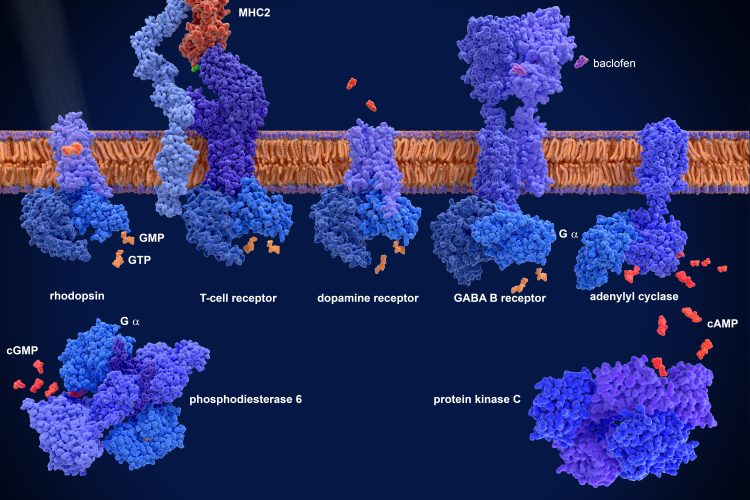How GPCR-targeting therapies are advancing the fight against inflammatory disease
Posted: 16 June 2025 | Stephan Schann (Chief Scientific Officer at Domain Therapeutics) | No comments yet
Discover how Domain Therapeutics is using its deep knowledge of GPCR biology to create novel therapeutics with the potential to combat inflammatory diseases such as atopic dermatitis, IBD and arthritis.


G protein-coupled receptors (GPCRs) are a highly validated drug target family – accounting for 30-35 percent of all approved drugs. Despite this, the therapeutic potential of targeting most GPCRs remains untapped, as only 10 percent of GPCRs have been drugged. In this article, Stephan Schann, Chief Scientific Officer at Domain Therapeutics, explains why this class of drug target is so useful despite the challenges they present.
GPCRs: the master cell signallers with huge therapeutic potential
GPCRs are the largest and most diverse group of cell-surface receptors in the body, with more than 800 known types in humans. They are at the heart of cellular communication, translating extracellular signals – such as hormones, smell, taste, light and neurotransmitters – into intracellular actions.
Moreover, GPCRs have a complex pharmacology, with each acting as a kind of signalling hub for an array of downstream signals, in contrast to simpler receptors which are generally responsible for one signal.
Biomarkers aren’t just supporting drug discovery – they’re driving it
FREE market report
From smarter trials to faster insights, this report unpacks the science, strategy and real-world impact behind the next generation of precision therapies.
What you’ll unlock:
- How biomarkers are guiding dose selection and early efficacy decisions in complex trials
- Why multi-omics, liquid biopsy and digital tools are redefining the discovery process
- What makes lab data regulatory-ready and why alignment matters from day one
Explore how biomarkers are shaping early drug development
Access the full report – it’s free!
All these features make GPCRs central to regulating many vital biological processes in the body, including immune responses and inflammation, and thus especially attractive for therapeutic intervention.
Targeting GPCRs to fight inflammatory diseases
GPCR-targeting drugs are well known therapies for a range of disease types, including cardio-metabolic, central nervous system and endocrinological disorders.
Yet although they are a proven drug target family with widespread utility, they remain largely underexplored for tackling inflammatory diseases.
Inflammation is a key part of the body’s immune defence, helping to increase blood flow to an area, isolating the threat, delivering an enhanced level of immune cells to the area, and initiating healing.
However, for various reasons our bodies can suffer from an overactivated inflammatory response, which can cause inflammatory conditions or diseases such as atopic dermatitis (AD), inflammatory bowel disease (IBD) and arthritis.
One well recognised driver of inflammatory responses is a GPCR called protease-activated receptor 2 (PAR2), which is activated by proteolytic cleavage.
One well recognised driver of inflammatory responses is a GPCR called protease-activated receptor 2 (PAR2), which is activated by proteolytic cleavage.
PAR2 has emerged as a pivotal therapeutic target in inflammatory diseases due to its unique ability to drive fine-tuned immune and inflammatory responses. Moreover, it also has demonstrated involvement in barrier integrity and pain – two additional components of many inflammatory diseases.
However, due to its unique biology and structural complexity, PAR2 has proven notoriously difficult for the pharmaceutical industry to effectively target.
For example, unlike most GPCRs, which rely on external ligands, PAR2 releases a tethered ligand that binds intramolecularly to activate the receptor. This makes conventional approaches, which attempt to target the orthostatic binding sites, less effective.
In addition, PAR2 can be activated by different proteases, which can each trigger distinct downstream signalling pathways.
For these reasons, PAR2 has long been regarded as one of the most challenging GPCR targets, having long eluded industry attempts to tame it with effective therapeutic solutions.
Domain’s approach: fine-tuned PAR2 modulation
Domain Therapeutics’ approach has been to develop DT-9046, a first-in-class, biased negative allosteric modulator (NAM) of PAR2 – meaning it is designed to inhibit the activity of PAR2 through an allosteric binding site, but this inhibition is achieved in a distinctive way.
Indeed, DT-9046 is termed a ‘biased’ modulator because it acts upon particular downstream signalling pathways triggered by PAR2, but not others.
DT-9046 is an orally delivered small molecule that has reached pre-IND studies – making Domain the first company to successfully advance a small molecule candidate targeting PAR2.
This very precise pharmacology – born out of Domain’s deep knowledge of GPCR biology shaped by more than two decades of expertise – means DT-9046 is capable of eliciting a fine-tuned response: disrupting harmful inflammatory processes while maintaining efficacy and minimising the risk of resistance.
While other PAR2-targeting strategies are primarily biologics and full antagonists, DT-9046 is an orally delivered small molecule that has reached pre-IND studies – making Domain the first company to successfully advance a small molecule candidate targeting PAR2.
Orally delivered small molecule therapies offer significant potential advantages over injectable antibody-based drugs, such as their ease of administration, popularity with patients, easier manufacturability, and better temporality control.
In March 2025, Domain Therapeutics disclosed DT-9046 as an oral drug candidate for inflammatory diseases, including AD, IBD and arthritis, as well as pain. It also holds potential for neuroinflammatory conditions such as certain types of migraine.
DT-9046 is currently progressing through pre-IND studies, supported by a robust data package, including head-to-head benchmarks and strong patent protection. Preclinical studies have demonstrated potent and selective modulation of the immune response, which plays a crucial role in various inflammatory conditions.
DT-9046 is currently progressing through pre-IND studies, supported by a robust data package, including head-to-head benchmarks and strong patent protection.
As biosimilars increase competition to blockbuster biologics such as AbbVie’s Humira (used to treat autoimmune conditions like rheumatoid arthritis), pharma companies are increasingly on the look-out for next-generation, disease-modifying drugs that will bring even greater benefits to patients with inflammatory diseases and limited treatment options. GPCR-targeting therapies such as DT-9046 represent a compelling opportunity in that respect, with major clinical and commercial potential.
The DT-9046 programme highlights Domain’s leadership in GPCR drug discovery and development, and its ability to crack challenging GPCR targets.
Supported by a strong IP and preclinical package, it broadens Domain’s pipeline beyond immuno-oncology and reinforces the potential of GPCRs to address unmet needs in inflammation.


Stephan Schann is Chief Scientific Officer at Domain Therapeutics. As the leader of Domain’s proprietary programmes and collaborations with pharma partners, he oversees the intellectual property strategy for each of the company’s assets. Stephan has been with Domain since its inception in 2008 and his roles have evolved over time, including previous positions as Head of Research, Director of Research & Development and Vice-President of Research & Development. With over 25 years of experience in biomedical research, Stephan has dedicated his career to the development of novel therapeutics addressing unmet medical needs. His significant contributions to drug discovery and development have been instrumental in shaping Domain’s success and its continuous growth. Prior to joining Domain, Stephan established and led the Medicinal Chemistry Department at Faust Pharmaceuticals and was a senior scientist at Evotec. Stephan holds a PhD in medical chemistry from University of Strasbourg in France.
Related topics
Biologics, Drug Discovery, Drug Discovery Processes, GPCRs, Small molecule
Related conditions
Arthritis, Atopic Dermatitis (AD), Inflammatory bowel disease (IBD), Neuroinflammatory conditions
Related organisations
Stephan Schann (Chief Scientific Officer at Domain Therapeutics)








